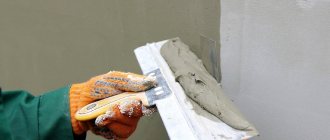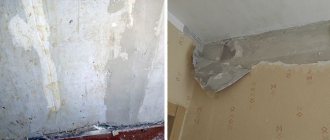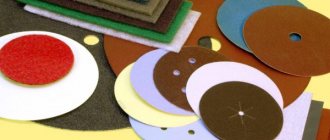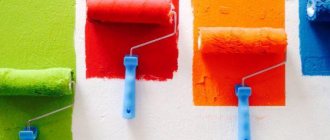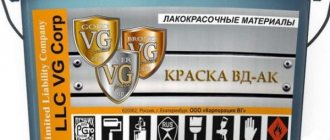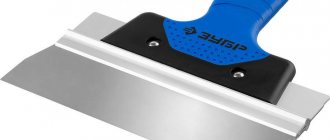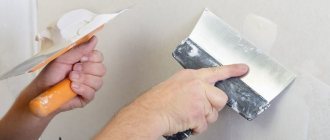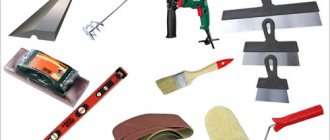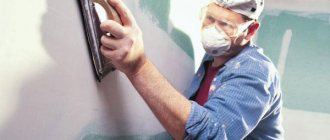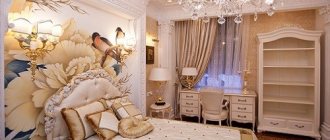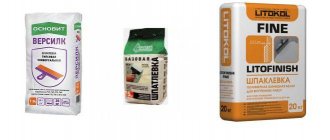High-quality surface finishing requires the application of a reliable base. Modern acrylic putty for walls copes with this task perfectly. Plastic material on a water-dispersed basis with the addition of synthetic latex is durable and functional. The plastic mass is perfectly distributed over the surface, dries without cracks or peeling. When choosing dry putty or a prepared mixture, it is important to understand their varieties.
Types of acrylic putty
Acrylic putties, since they are produced only in finished form, can be divided according to the types of work that can be performed with them:
1) Putty for interior work. This material is only suitable for rooms with a normal microclimate, without high humidity and steam.
2) Facade . It is used for exterior decoration of buildings and structures, and can also be used inside, provided there is a “wet” room.
3) Universal. Can be used for external and internal work.
It should also be noted that the scope of application of acrylic putties is very wide compared to other finishes. Acrylic can be applied not only to brick or concrete, but also to drywall, and even wooden or metal surfaces. This is also an absolute advantage of acrylic putties.
Differences from latex putty
Sometimes, if there is no acrylic putty in the store, sellers offer to purchase latex putty. These compositions are similar in many ways, since in both cases a polymer component is used as a base. That being said, latex is still better in terms of performance. In particular, latex is characterized by higher strength, durability and resistance to negative environmental influences. Latex putties are also less prone to cracking compared to acrylic putties.
Just like acrylic, latex compositions are sold in ready-to-use form. Latex mixtures can be tinted to the desired color if desired.
Pros and cons of acrylic putties
Although acrylic putties are practically universal and often used, of course, they, like any material, have their advantages and disadvantages. To make the right purchasing decision, it is worth considering all the details.
Pros:
- No smell. Acrylic putties are made on a water basis, they do not contain a solvent, even an organic one, and therefore there is no aroma.
- Excellent adhesion. Thanks to this property, the material can be used on any surface.
- Thin layer. Finishing acrylic putties can be applied in literally one millimeter layer! This allows them to produce a very thin and smooth surface.
- Plastic consistency. Acrylic putties have the most ideal elasticity, compared, for example, with gypsum or cement. Even an amateur in finishing work can work with this material.
- There is no shrinkage. After drying, the finishing layer remains practically unchanged, the shrinkage of the acrylic putty is minimal and not noticeable to the naked eye.
- Resistant to ultraviolet radiation , not afraid of direct sunlight.
- Highly durable. Surfaces finished with acrylic putty can withstand moderate mechanical stress without problems. Compared to others, such as gypsum putties, acrylic putties create a much more durable layer.
- Long service life. Acrylic putties can last in their original form for many years. They do not turn yellow, do not crack, do not collapse for ten or even more years.
- Tinting. Acrylic putties belong to the type of finishing materials that can be easily tinted. Before starting work, you can add colorants to them, mix well and get a colored finish. This is convenient because you don’t need double work: putty + painting, and also, if subsequently, for example, with a strong impact, a chip is formed, then it will not be noticeable in the painted putty.
- Safe for health. The composition of acrylic putties is completely safe for health, it meets all necessary environmental control standards.
- Fireproof. Acrylic putty is absolutely fireproof. It does not burn, does not ignite, does not smolder.
- Thermal insulation properties. This finishing material helps retain heat in the room and has proven to be an excellent additional heat insulator.
As you can see, the advantages of acrylic-based putties are many and all of them are significant, which effectively works for the overall image of this finishing material. Due to its rich advantages, acrylic putty is widely in demand.
Minuses:
Grinding. No matter how carefully and thinly the layer of putty is applied, it still needs to be sanded after complete drying - this is the only way to get a perfectly flat surface. Acrylic putties are quite difficult to sand, as they generate a lot of dust. Because of this, it is imperative to work in a respirator, and also change the sandpaper as often as possible, since dust clogs the abrasive and it stops sanding properly.
Thin layer. On the one hand, the fact that acrylic putties are applied only in a thin layer is an advantage, on the other hand, it can also be a disadvantage. This happens when there is a need to level out significant differences. For acrylic putties, a layer of more than 7 mm is unacceptable! This means, if necessary, it must be applied in two or more layers.
Low air temperatures. Acrylic putty loses the consistency required for work at ambient temperatures below ten degrees Celsius. It becomes inelastic and is not so easy to apply, and it shouldn’t be. Acrylic finishes should only be worked in a warm environment.
Price. Acrylic composition is not a cheap pleasure; all materials based on it have a high cost. Of course, it is fully justified by the high quality and properties of the product.
Of course, if we talk about the advisability of buying acrylic putty, then despite its shortcomings, the advantage will still be significant.
The only significant disadvantage affecting the purchase of this material may be its price. In this case, specialists often do a combination of things: for the initial work they use more budget-friendly brands of putty, and then the final finishing is done with acrylic-based material.
Recommendations for selection
The paste-like water-dispersed mixture is produced by different manufacturers. In order not to make a mistake with your choice, it is important to carefully read the technical description. It is usually indicated that this is a universal acrylic putty or a specialized composition.
The possibilities of acrylates are vast. One paste can be used to prepare for painting, hiding defects on radiators and window sills, on brickwork, wood and concrete beams. You can buy universal formulations without fear.
This is a unique material for attic finishing. It adheres well to negative surfaces made from a variety of materials, including wood, metal and drywall. If possible, purchase highly specialized putties so as not to worry about peeling.
The material is very practical; fillers can be added to it and used as plaster. After finishing work, it is better to apply a protective acrylic varnish - matte or semi-gloss.
It is recommended to pay attention to the manufacturer's brand. It can be argued that the primer, putty and varnish of the same company are most compatible.
It is important to carefully study the description of the recommendations. If technology is violated, no one guarantees an ideal result. Diluted dry mixtures (in the specified proportion) are suitable for wallpaper. They are cheaper, but the quality is lower, and components of a large fraction may come across. For painting, take the ready-made composition. The choice of tool and preliminary experience are important - it is advisable to make a few strokes on a “training” plane.
If possible, purchase highly specialized putties so as not to worry about peeling.
Putties based on acrylates and latex polymers are gaining popularity. Universal acrylic putty is chosen by beginners; they are recommended by experts. This is good value for money with excellent results. The treated surface looks flawless, thanks to the plasticity of the mass, which is pleasant to work with.
Working with acrylic putty
In order for the coating to serve for many years and remain intact and visually attractive, it must be applied correctly. Working with acrylic has its own nuances that are worth paying attention to.
1. Surface preparation. In no case should you be irresponsible about this stage and skip it or perform it in bad faith. It is very important that the surfaces are clean, free of dust and traces of dirt, grease stains and the like. Otherwise, the acrylic putty may lie unevenly or not adhere firmly and fall off over time.
If you plan to work on sealing cracks or crevices, they must first be cleared of remnants of building material and dirt, and must also be provided with free access for dense placement of putty. Laying acrylic putty with gaps is unacceptable - in this case, sealing the cracks may be ineffective.
2. Primer. When working with acrylic putties, priming is a mandatory step and cannot be ignored to achieve a quality finish. Primers in this case are also used on an acrylic base, but the specific type is selected depending on the source material of the surface. For example, if you have clean concrete walls, then they need to be primed with a special adhesive primer, and if the surface is pre-plastered, then a deep penetration primer would be the best choice. There are also universal acrylic primers for atypical cases.
The primer is easy to apply even on your own - it is best to do this with a soft velor roller or a special natural brush. When distributing the composition, you need to make sure that there are no dry areas left, and if there are cracks or chips, then pay special attention to these places and thoroughly moisten them with primer. After the first layer has dried, re-application is necessary. And only after the second layer of primer has completely dried - and this takes about a day - can you begin subsequent work.
3. Puttying the surface. Acrylic putties have a good elastic consistency, making them easy to work with. The easiest way to apply them is with a simple metal spatula of medium or large size, transferring the mass from the bucket onto it with a small spatula. If the putty is too thick and difficult to spread over the surface, you can dilute it with ordinary clean water at room temperature. You shouldn’t add a lot of water at once; it’s better to do it in doses, in small portions, stirring the mass thoroughly, otherwise it’s easy to turn a thick mass into a very liquid one, which will be much more difficult to correct.
4. Surface cleaning. When the putty hardens well - the hardening time is always indicated on the packaging, it must be sanded to a smooth, even state. The easiest way to do this is with sandpaper or mesh. They are fixed on hand graters or on a special hammer drill attachment, depending on the size of the area being treated. When performing grinding work, it is imperative to follow safety precautions: wear a respirator, safety glasses - a lot of dust is generated in the process.
If there is a need to apply subsequent layers of putty, then after sanding the first layer, it must be cleaned of dust and primed, and then puttyed again with acrylic putty. No matter how many layers are needed, the algorithm of actions must be followed the same: sanding - cleaning - priming - putty. After applying the last layer of putty and before further finishing, it is also necessary to apply a primer.
Calculation of material consumption
Uniform application in a thin layer saves material. Before purchasing, it is important to pre-calculate the consumption of acrylic paste.
Practice shows that approximately 1.1 - 1.2 kg of the finished mixture is consumed per 1 m² of area, if the layer is about 1 - 2 mm. Each repeated layer requires about 1 kg/1 m² of area, but it is better to take it with a reserve.
If it is necessary to level the putty, more is required, up to 1.5 kg/1 m² of area. A layer of about 1 mm is enough for wallpapering walls. Before painting, you have to prepare the coating more carefully - the costs will increase.
Uniform application in a thin layer saves material.
Terms of use
Among other things, it is important not only to choose high-quality material, but also to follow all the rules for its use. So take note of them:
- the room temperature should be between 5-30 degrees;
- the surface should not be exposed to direct sunlight;
- The humidity level in the room should not be higher than 80%, but not lower than 50%.
And to understand which putty for the ceiling is better, you should take a closer look at the types of materials.
Conclusion
Now you know what acrylic putty is, what properties it has and how to use it. Watch the additional video in this article. If you have any questions on this topic, you can contact me in the comments.
Did you like the article? Subscribe to our Yandex.Zen channel
June 5, 2022
Construction Chemicals, Plaster and Wall Putty
If you want to express gratitude, add a clarification or objection, or ask the author something, add a comment or say thank you!
Where can it be used?
The use of acrylic-based putty is quite widespread. It can be used for leveling external and internal walls, ceilings, for repairing and finishing wooden structures, plasterboard and concrete surfaces.
Filling cavities, cracks, and recesses from anchors is also not complete without this mixture.
The versatility of acrylic putty for walls allows it to be used both at home and outdoors. In addition, it can also be used for puttying construction bandages.
Optimal composition
Another important factor is the content of certain modifiers in the putty. These substances ensure easy smoothing of the mixture over the surface, prevent it from flowing down the tools and prevent peeling from the ceiling surface.
In addition, the drying time of the material depends on such additives:
- gypsum putties tend to harden within an hour;
- the cement material remains in its original form for approximately 2.5 hours;
- polymer mixtures are highly resistant and may not lose their properties for two days, however, provided they are properly stored and applied.
